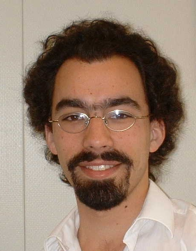Multiple light scattering in porous gallium phosphide
Promotion Date: 14 July 2005
| The main subject of my thesis is multiple light scattering. The multiple light scattering in various materials is nicely illustrated on the cover of my book by the powdered sugar, the whipped egg white and the cauliflower. We are talking about light here; multiple scattering means that the light does not propagate in a straight line but ‘bounces’ around in the material. All white substances due their color to multiple light scattering. Multiple scattering randomizes the direction of the light, so that the color of the material is given by the average of all colors shining on it. Under a white light illumination (e.g., from the sun, or an incandescent lamp), the material with multiple scattering appears white. |
What was your thesis about?
The main subject of my thesis is multiple light scattering. The multiple light scattering in various materials is nicely illustrated on the cover of my book by the powdered sugar, the whipped egg white and the cauliflower. We are talking about light here; multiple scattering means that the light does not propagate in a straight line but ‘bounces’ around in the material. All white substances due their colour to multiple light scattering. Multiple scattering randomizes the direction of the light, so that the colour of the material is given by the average of all colours shining on it. Under a white light illumination (e.g., from the sun, or an incandescent lamp), the material with multiple scattering appears white. The only difference between powder sugar (which is white) and candy sugar (which is transparent) is the size of the crystals, otherwise identical. The latter let light propagate, whereas the former let light propagate, but also scatter numerous times from crystal to crystal. The constituent of white materials should not have any absorption.
The purpose of my thesis and other research conducted over the past two decades is to see whether there are any interference effects remaining after numerous scattering events. My thesis focuses on the interference effects in gallium phosphide (a semi-conductor transparent for the red and yellow part of the spectrum) made porous. A porous material is in fact the opposite of a powder: a powder comprises small particles embedded in air whereas in a porous substance the air is included in the material itself. Egg white for instance is transparent, but when whipped -meaning inserting air bubbles-, it becomes white. The pores in the gallium phosphide are so small that they are close to the wavelength of the light, making it the strongest scattering material for visible light in the world. The stronger the scattering is, the more difficult light can diffuse through the material. With enough scattering, a phase transition occurs, which traps light inside the material. This effect is called localization, and this is our goal.
Why this goal?
Primarily because it is interesting from a fundamental-physics point of view. It is different from everything we can see in nature. In nature, light is always propagating or absorbed.
So if you were to find this entirely new state in nature, it just might open up a range of possibilities that we cannot exactly imagine now.
The promising research area of photonic crystals, also conducted on a large scale in this institute, is derived from the multiple light scattering research. So from one thing comes another.
And did you manage to catch the light?
It was not for the want of trying and I definitely made steps forward, but I did not completely localize the light.
But what was your main conclusion?
My main conclusion is that this material, porous gallium phosphide, is indeed a very strongly scattering material, but which can still be described by classical diffusion. Our hopes were up for localizing light in porous materials. We were nearly there, but not quite.
Were you disappointed about that?
Yes, sure, the main goal was localization. But the good thing about what you could call a ‘negative’ conclusion is all the things you find out as side tracks, on which I have written a few articles. So I am very happy about what I achieved in these four years.
I am also happy about the multidisciplinary aspects in my research. You get a lot of new ideas if you are actually making your own samples, even if you are not a chemist, or doing theory, even if you are not a 'real' theorist. It is important not only to focus on what you are supposed to do, but also have an eye for all the interesting features that you come across in getting there. That is what I enjoyed most about my research and of course, everything else.
Everything else?
Yes, almost as important as the research itself: you learn how to collaborate, how to get things done, how to critically analyze your results, to write articles and present yourself in conferences. In short, you learn how to be a good scientist. Good scientists have an open mind and a curious attitude that is not limited to their own specific field.
What didn’t you like?
Not having achieved localization. On the other hand, people have been looking for it for two decades and it is still very elusive, so that a lot of people have the same feeling.
You have an excellent command of the Dutch language, but you are not from the Netherlands?
No, I am French, I studied in Paris. I may go back there, but I am also writing up a proposal for a postdoc in Portugal. My girlfriend is from there and I would like to join her. It gives me an opportunity to also really learn Portuguese. To really learn a language or a culture, you have to be in the country itself.
For the summary of the thesis, click here.

